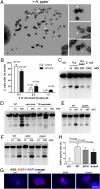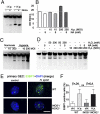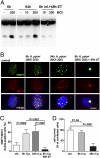Carcinogenic bacterial pathogen Helicobacter pylori triggers DNA double-strand breaks and a DNA damage response in its host cells
- PMID: 21896770
- PMCID: PMC3169107
- DOI: 10.1073/pnas.1100959108
Carcinogenic bacterial pathogen Helicobacter pylori triggers DNA double-strand breaks and a DNA damage response in its host cells
Abstract
The bacterial pathogen Helicobacter pylori chronically infects the human gastric mucosa and is the leading risk factor for the development of gastric cancer. The molecular mechanisms of H. pylori-associated gastric carcinogenesis remain ill defined. In this study, we examined the possibility that H. pylori directly compromises the genomic integrity of its host cells. We provide evidence that the infection introduces DNA double-strand breaks (DSBs) in primary and transformed murine and human epithelial and mesenchymal cells. The induction of DSBs depends on the direct contact of live bacteria with mammalian cells. The infection-associated DNA damage is evident upon separation of nuclear DNA by pulse field gel electrophoresis and by high-magnification microscopy of metaphase chromosomes. Bacterial adhesion (e.g., via blood group antigen-binding adhesin) is required to induce DSBs; in contrast, the H. pylori virulence factors vacuolating cytotoxin A, γ-glutamyl transpeptidase, and the cytotoxin-associated gene (Cag) pathogenicity island are dispensable for DSB induction. The DNA discontinuities trigger a damage-signaling and repair response involving the sequential ataxia telangiectasia mutated (ATM)-dependent recruitment of repair factors--p53-binding protein (53BP1) and mediator of DNA damage checkpoint protein 1 (MDC1)--and histone H2A variant X (H2AX) phosphorylation. Although most breaks are repaired efficiently upon termination of the infection, we observe that prolonged active infection leads to saturation of cellular repair capabilities. In summary, we conclude that DNA damage followed by potentially imprecise repair is consistent with the carcinogenic properties of H. pylori and with its mutagenic properties in vitro and in vivo and may contribute to the genetic instability and frequent chromosomal aberrations that are a hallmark of gastric cancer.
Conflict of interest statement
The authors declare no conflict of interest.
Figures




References
-
- Marshall BJ, Warren JR. Unidentified curved bacilli in the stomach of patients with gastritis and peptic ulceration. Lancet. 1984;1:1311–1315. - PubMed
-
- Parsonnet J, Isaacson PG. Bacterial infection and MALT lymphoma. N Engl J Med. 2004;350:213–215. - PubMed
-
- Rieder G, Merchant JL, Haas R. Helicobacter pylori cag-type IV secretion system facilitates corpus colonization to induce precancerous conditions in Mongolian gerbils. Gastroenterology. 2005;128:1229–1242. - PubMed
-
- Fox JG, et al. Helicobacter pylori-associated gastric cancer in INS-GAS mice is gender specific. Cancer Res. 2003;63:942–950. - PubMed
Publication types
MeSH terms
Substances
LinkOut - more resources
Full Text Sources
Other Literature Sources
Medical
Molecular Biology Databases
Research Materials
Miscellaneous

